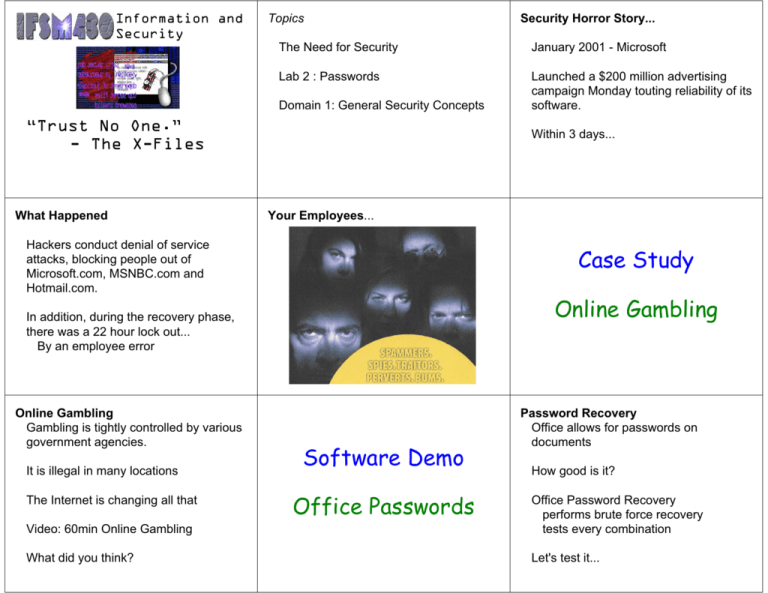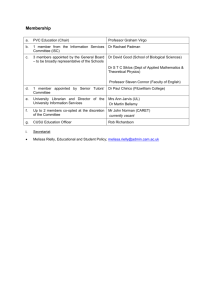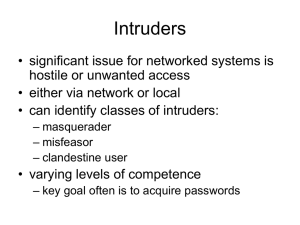Case Study Online Gambling Software Demo Office
advertisement

Information and Security Topics The Need for Security January 2001 - Microsoft Lab 2 : Passwords Launched a $200 million advertising campaign Monday touting reliability of its software. Domain 1: General Security Concepts “Trust No One.” - The X-Files What Happened Within 3 days... Your Employees... Hackers conduct denial of service attacks, blocking people out of Microsoft.com, MSNBC.com and Hotmail.com. Case Study Online Gambling In addition, during the recovery phase, there was a 22 hour lock out... By an employee error Online Gambling Gambling is tightly controlled by various government agencies. It is illegal in many locations The Internet is changing all that Security Horror Story... Software Demo Password Recovery Office allows for passwords on documents How good is it? Video: 60min Online Gambling Office Password Recovery performs brute force recovery tests every combination What did you think? Let's test it... Office Passwords Business Needs First Chapter 2 The Need for Security Our bad neighbor makes us early stirrers, Which is both healthful and good husbandry. -- William Shakespeare (1564–1616) King Henry, in Henry V, act 4, sc. 1 Enabling the Safe Operation of Applications Organization need environments that safeguard applications using IT systems Management must continue to oversee infrastructure once in place—not defer to IT department Information security performs four important functions for an organization Protects ability to function Enables safe operation of applications implemented on its IT systems Protects data the organization collects and uses Safeguards technology assets in use Protecting Data that Organizations Collect and Use Organization, without data, loses its record of transactions and/or ability to deliver value to customers Protecting data in motion and data at rest both critical aspects of information security Protecting the Functionality of an Organization Management (general and IT) responsible for implementation Information security is both management issue and people issue Organization should address information security in terms of business impact and cost Safeguarding Technology Assets in Organizations Organizations must have secure infrastructure services based on size and scope of enterprise Additional security services may be needed as organization expands More robust solutions may be needed to replace security programs the organization has outgrown Threats Threats (continued) Threat: an object, person, or other entity that represents a constant danger to an asset The 2004 CSI/FBI survey found: Management must be informed of the different threats facing the organization By examining each threat category, management effectively protects information through policy, education, training, and technology controls 79 percent of organizations reported cyber security breaches within the last 12 months 54 percent of those organizations reported financial losses totaling over $141 million Threats to Information Security Acts of Human Error or Failure Acts of Human Error or Failure (continued) Includes acts performed without malicious intent Employee mistakes can easily lead to: Causes include: Inexperience Improper training Incorrect assumptions Employees are among the greatest threats to an organization’s data Figure 2-1 – Acts of Human Error or Failure Revelation of classified data Entry of erroneous data Accidental data deletion or modification Data storage in unprotected areas Failure to protect information Many of these threats can be prevented with controls Compromises to Intellectual Property Deliberate Acts of Espionage or Trespass Intellectual property (IP): “ownership of ideas and control over the tangible or virtual representation of those ideas” Access of protected information by unauthorized individuals The most common IP breaches involve software piracy Two watchdog organizations investigate software abuse: Software & Information Industry Association (SIIA) Business Software Alliance (BSA) Enforcement of copyright law has been attempted with technical security mechanisms Competitive intelligence (legal) vs. industrial espionage (illegal) Shoulder surfing occurs anywhere a person accesses confidential information Controls let trespassers know they are encroaching on organization’s cyberspace Hackers uses skill, guile, or fraud to bypass controls protecting others’ information Deliberate Acts of Espionage or Trespass Deliberate Acts of Espionage or Trespass (continued) (continued) Expert hacker Unskilled hacker Develops software scripts and program exploits Many more unskilled hackers than expert hackers Usually a master of many skills Use expertly written software to exploit a system Will often create attack software and share with others Do not usually fully understand the systems they hack Deliberate Acts of Espionage or Trespass (continued) Other terms for system rule breakers: Cracker: “cracks” or removes software protection designed to prevent unauthorized duplication Deliberate Acts of Information Extortion Deliberate Acts of Sabotage or Vandalism Attacker steals information from computer system and demands compensation for its return or nondisclosure Attacks on the face of an organization—its Web site Commonly done in credit card number theft Threats can range from petty vandalism to organized sabotage Web site defacing can erode consumer confidence, dropping sales and organization’s net worth Phreaker: hacks the public telephone network Threat of hacktivist or cyber-activist operations rising Cyber-terrorism: much more sinister form of hacking Figure 2-5 - Cyber Activists Wanted Deliberate Acts of Theft Deliberate Software Attacks Illegal taking of another’s physical, electronic, or intellectual property Malicious software (malware) designed to damage, destroy, or deny service to target systems Physical theft is controlled relatively easily Includes viruses, worms, Trojan horses, logic bombs, back doors, and denial-of-services attacks Electronic theft is more complex problem; evidence of crime not readily apparent Forces of Nature Deviations in Quality of Service Forces of nature are among the most dangerous threats Includes situations where products or services not delivered as expected Disrupt not only individual lives, but also storage, transmission, and use of information Organizations must implement controls to limit damage and prepare contingency plans for continued operations Information system depends on many interdependent support systems Internet service, communications, and power irregularities dramatically affect availability of information and systems Internet Service Issues Internet service provider (ISP) failures can considerably undermine availability of information Outsourced Web hosting provider assumes responsibility for all Internet services as well as hardware and Web site operating system software Communications and Other Service Provider Issues Power Irregularities Commonplace Other utility services affect organizations: telephone, water, wastewater, trash pickup, etc. Loss of these services can affect organization’s ability to function Lead to fluctuations such as power excesses, power shortages, and power losses Organizations with inadequately conditioned power are susceptible Controls can be applied to manage power quality Technical Hardware Failures or Errors Technical Software Failures or Errors Occur when manufacturer distributes equipment containing flaws to users Purchased software that contains unrevealed faults Can cause system to perform outside of expected parameters, resulting in unreliable or poor service Some errors are terminal; some are intermittent Attacks Combinations of certain software and hardware can reveal new software bugs Entire Web sites dedicated to documenting bugs Table 2-2 - Attack Replication Vectors Antiquated/outdated infrastructure can lead to unreliable, untrustworthy systems Proper managerial planning should prevent technology obsolescence; IT plays large role Attacks (continued) Malicious code: includes execution of viruses, worms, Trojan horses, and active Web scripts with intent to destroy or steal information Act or action that exploits vulnerability (i.e., an identified weakness) in controlled system Accomplished by threat agent which damages or steals organization’s information Technological Obsolescence New Table Hoaxes: transmission of a virus hoax with a real virus attached; more devious form of attack Back door: gaining access to system or network using known or previously unknown/newly discovered access mechanism Attacks (continued) Attacks (continued) Password crack: attempting to reverse calculate a password Denial-of-service (DoS): attacker sends large number of connection or information requests to a target Brute force: trying every possible combination of options of a password Dictionary: selects specific accounts to attack and uses commonly used passwords (i.e., the dictionary) to guide guesses Attacks (continued) Figure 2-9 - Denial-of-Service Attacks Target system cannot handle successfully along with other, legitimate service requests May result in system crash or inability to perform ordinary functions Distributed denial-of-service (DDoS): coordinated stream of requests is launched against target from many locations simultaneously Figure 2-11 - Man-in-the-Middle Spoofing: technique used to gain unauthorized access; intruder assumes a trusted IP address Man-in-the-middle: attacker monitors network packets, modifies them, and inserts them back into network Spam: unsolicited commercial e-mail; more a nuisance than an attack, though is emerging as a vector for some attacks Attacks (continued) Mail bombing: also a DoS; attacker routes large quantities of e-mail to target Sniffers: program or device that monitors data traveling over network; can be used both for legitimate purposes and for stealing information from a network Social engineering: using social skills to convince people to reveal access credentials or other valuable information to attacker Attacks (continued) “People are the weakest link. You can have the best technology; firewalls, intrusion-detection systems, biometric devices ... and somebody can call an unsuspecting employee. That's all she wrote, baby. They got everything.” —Kevin Mitnick “Brick attack”: best configured firewall in the world can’t stand up to a well-placed brick Attacks (continued) Buffer overflow: application error occurring when more data is sent to a buffer than can be handled Timing attack: relatively new; works by exploring contents of a Web browser’s cache to create malicious cookie Setting Password Complexity Log in as administrator Administrative Tools Local Security Policy Account Policies Password Policy Passwords must meet complexity reqs Enable Log Off Administrator Logon on as User1 Change Password What happens? Run As Command It is best if the administrator uses a normal account, and then use the Run As command to do administration work. Log in as User 2 Try to open Local Security Policy Shift/Right Click on Local Security Policy Select Run As Log in as Administrator Hands On Security+ Lab 2: Passwords Preventing Display of Last Login Log in as administrator Administrative Tools Local Security Policy Security Options Do not display last name in login ... Enable Log Off Administrator Ctrl-Alt-Del to login What happens? Setting Password Length Log in as administrator Administrative Tools Local Security Policy Account Policies Password Policy Minimum Password Length Set Length to 9 Log Off Administrator Logon on as User1 Change Password What happens? Account Lockout Policy Log in as administrator Administrative Tools Local Security Policy Account Policies Account Lockout Policy Account Lockout threshold Set to 3 Lockout Duration and Reset Log Off Administrator Use the wrong password for User2 What happens? 1.4 Attacks Security+ Domain 1: General Security Concepts Active Passive Password Malicious Code Cryptographic DoS/DDos DDoS Denial of Service Attack Single / Distributed Buffer Overflows Very Common Prevent access to services Resource Consumption Demo: buffer.cpp Malformed Packets SYN Attacks Spoofing Faking Return Address Used to prevent trace back Also used in Denial of Service What can be spoofed IP, MAC, User, Date... Anything... URL Spoofing Capture another page Man in the Middle Attacks URL Spoofs Misspellings aool.com Similar names Mdonalds.com Assumed Names Dole96.org Other Domains nasa.com Others Replay Point user to Attacker Site DNS poisoning Pump Search Engine TCP/IP Hijacking Wardialing http://microsoft.com http://microsoft.com@attack.com Wardriving Dumpster Diving 1.6 Social Engineering 1.7 Vulnerability Scanning Password Attacks Just Ask Them Find open ports and services Brute Force Kevin Mitnick Can use used by System Administrators Secure Systems Attackers Find Weaknesses Dictionary Based Pizza - 1997 Schwan's targets Kraft Need Production Information Posed as reporter, student... 300,000 pizzas a day 1.5 Malicious Code Malware Virus Trojan Horse Logic Bombs Worms Back Door Examples Office Password Recovery Sniffing Viruses Parasitic Bootstrap sector Multi-partite Companion Link Data file (Macro) Some Statistics NCSA: 1 Billion a year $800 per infected computer $10 per computer Every Fortune 500 has reported 1 in 300 emails contains virus More Statistics Viruses One Report 200+ new viruses a month Costs: $16,000 in lost data and productivity Code fragment that attaches to a larger program Norton 3 new Viruses a day Replicates Is not independent Destructive Payload Symantec virus spread program Memory Resident File Infection Worms Independent program Duplicates itself Spreads to other systems Trojan Horses FLAG.EXE Says it does one thing, but really does something else Program to display the US flag and Play the National Anthem Steal passwords, files, etc On RBBS systems, would look for the Master Password file Stand alone Copy Password file to FLAG.BAS in the Downloading Area Trap Doors Spoofs Back door, bypass security Tricks users into giving away info Removed before shipment Tricks them into thinking their system is under attack Leaves very big hole in system Typically lead to a supervisor state and bypass normal audit trails Bombs Code planted deep in system Logic Bomb, Time bomb Typical Dec 31 "Employee # not in Payroll File" Used in commercial programs for copy protection and lease Protecting Boot from known floppy Install only licensed software Don't install if package was opened Don't install software from home Install only needed software Be careful with downloads Run against virus scanner before installing Backups Remedies Anti-virus programs Melissa - MS Word Macro Virus In Depth Spyware monitors Firewalls Keep them up to date! Melissa - Secondary Effect Melissa Timeline Saturday, March 27 , AM Researchers discover that the virus includes traceable identification numbers (GUIDs). Phar Lap Software's Richard M. Smith reverse-engineers an IP address from Melissa's GUID. The Melissa Macro Virus Melissa Timeline Friday, March 26, AM Melissa Timeline Friday, March 26, PM Posted to alt.sex message board, allegedly by skyrocket@aol.com. Infects U.S. companies, swamping e-mail systems. Named 'Melissa,' after comments by 'Kwyjibo' found inside the virus. National Infrastructure Protection Center notified of Melissa. Anti-virus firms believe Melissa originated in Western Europe. Anti-virus companies call it the most prolific virus -- ever. Melissa Timeline Saturday, March 27 , PM FBI warns U.S. organizations to watch out for Melissa on Monday. More U.S. companies hit. Some companies revert to paper, rather than e-mail, warnings Melissa Timeline Monday, March 29 , AM Many IT departments stop the virus. An Excel strain of Melissa, nicknamed Papa, surfaces. The FBI launches a manhunt for Melissa's creator. Melissa Timeline Monday, March 29 , PM Traced to SkyRocket on AOL and Source of Kaos, a Web site run by VicodinES, a 'retired' virus writer. Melissa Timeline Tuesday, March 30, AM Source of Kaos site is unplugged. Many IT workers report that they have contained the virus Owner of the SkyRocket account says he is not Melissa's creator. Kaos' site hasn't been active Melissa Timeline Thursday, April 1, AM AOL is presented with a court order from a state judge in New Jersey requesting information concerning the Melissa virus. Final Results How much is your time worth? If you're David Smith, creator of the Melissa virus, it's apparently worth a whopping $4 million a month. Smith was sentenced in a New Jersey courtroom on May 1, 2002, receiving only twenty months in Federal prison and a $5,000 fine for creating and distributing the virus which is estimated to have caused $80 million in damage. Melissa Timeline Thursday, April 1, PM New Jersey police arrest David L. Smith, 30, of Aberdeen on charges of originating the Melissa virus outbreak. New Jersey's attorney general says Smith was snared with the help of AOL technicians. Melissa Timeline Tuesday, March 30, PM New variants of Melissa are reported in the wild. The FBI seizes Source of Kaos' Web server in Orlando, Fla. Also talks to Source of Kaos's Roger Sibert -- asking questions about the whereabouts of VicondinES Melissa Timeline Friday, April 2, AM David Smith, described as a 'computer guy,' is released on $100,000 bail. Faces 40 years, $480,000 fines Got: $5,000 and 20 months Video: Melissa Windows vs. Linux October 2004 Steve Balmer talks about Windows and Linux Security. What do you think? Do you think anything has changed over the past 2 years? End of Presentation








